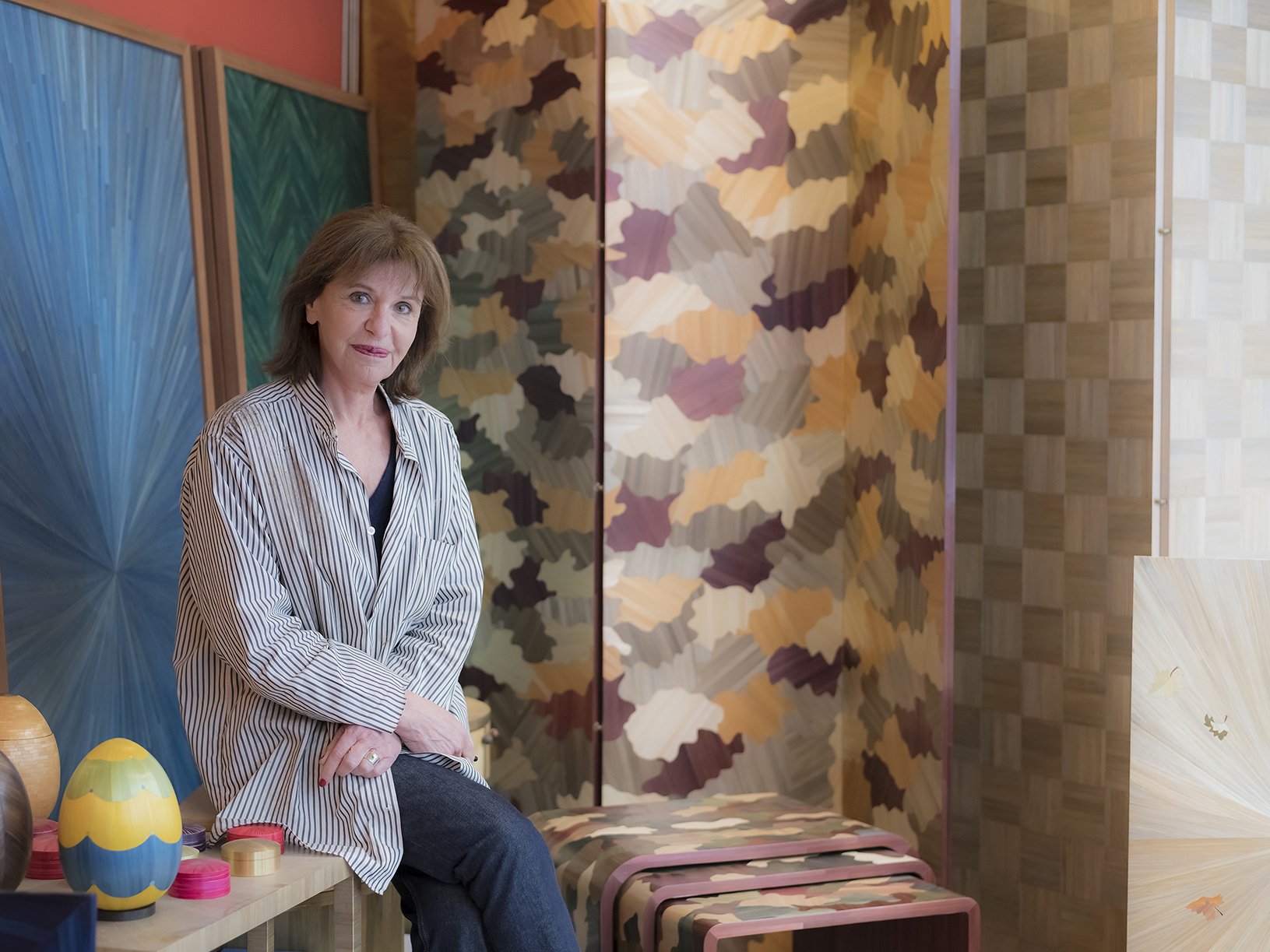Going with The Grain: Q&A with Lison de Caunes, the Grande Dame of Straw Marquetry
Report 13 cover star Lison de Caunes – granddaughter of Art Deco master André Groult – tells The Textile Eye about growing up in her acclaimed grandfather’s design studio, reviving straw marquetry savoir faire, and why the material is so popular for furniture and interiors today.
A preview of our Q&A with Lison de Caunes, excerpted from from Report 13: Paris in Spring.
Lison de Caunes in her Atelier, surrounded by Lison de Caunes Créations screens, stools, wall panels, and accessories. The camo screen and nesting tables were made for AD Collections exhibition in 2017. Photo courtesy of Ateliers Lison de Caunes.
Going with the Grain
As a child, Lison de Caunes became fascinated by the forgotten art form of straw marquetry after discovering it in her designer grandfather’s workshop. A lifelong passion for the entirely manual craft led her to revolutionize the traditional technique with her own innovative applications, while also reviving interest in straw marquetry. In the early 1970's, Lison began working with straw marquetry, restoring masterpieces from the 18th, 19th and 20th centuries. Excited to modernize the medium, she established Ateliers Lison de Caunes in 1978, and began collaborating with designers like Peter Marino, Cabinet Alberto Pinto, Hubert le Gall, Vincent Darré and Mathieu Lahanneur, and luxury brands like Louis Vuitton and Cartier. In 2015, she launched her own brand of furniture and objects, Lison de Caunes Créations. Today, her artisanal, sustainable furniture, objects, and wallcoverings bear the hallmarks of her continual quest for modernization—exquisite objects of art elevated by gold leaf, mother-of-pearl, and molten glass inlays.
Collaboration with interior designer Constant Clesse to showcase the savoir-faire of the Par Elegance Showroom brands. Photo courtesy of Ateliers Lison de Caunes.
Detail of Paravent in Camo. Photo courtesy of Ateliers Lison de Caunes.
From the cover: A detail of the top of an original Lison de Caunes Créations table, Hélices. Photo courtesy of Ateliers Lison de Caunes.
Boite a Soleil, Pierre Marie x Ateliers Lison de Caunes. Photo courtesy of Ateliers Lison de Caunes.
High-End, Low Carbon
“Straw marquetry is one of the only materials today that brings such a shine without a glittering effect–and without adding varnish” Lison notes. “Also, the environmental aspect of the raw material (each year the rye straw is harvested by specialized cereal growers in the Burgundy region of France) is an essential element in design today. Plus, the technique does not require water or machinery and thereby no electricity is used in the production process, lending straw marquetry a low carbon footprint. Despite its seemingly fragile appearance, straw marquetry is much more resilient than you might think, making it a suitable material for wall applications as well as furniture.”
Lison de Caunes finalizing a design. Photo courtesy of Ateliers Lison de Caunes.
Dyed rye straw bundles, ready to be flattened and made into a surface design. Photo courtesy of Ateliers Lison de Caunes.
You will find a portrait of André Groult, Lison de Caunes’ grandfather, on the wall in the workshop. Photo courtesy of Ateliers Lison de Caunes.
Making Historical Craft Modern
When asked about her craft ethos, Lison replies, “I am very inspired by decorative art, but I am also influenced by the 17th century craft of straw marquetry. I have a real desire to modernize and innovate my knowledge and skills.”
“Most of the time, designers or interior designers come to us with a project (table, cabinets, entire rooms) that they want to be covered in straw. We then choose with them the best pattern and color. We receive MDF panels or MDF pieces of furniture in our workshop in Paris where everything is made either by me or one of the artisans who work at the workshops. When the project is entire walls, the panels are sent on-site, installed, and then we come to do the final touch-ups and finishes.”
Mural work in straw marquetry, with lacquer and gold leaf by Atelier Midavaine, designed by Ateliers Muquet. Original design by Agence Moinard Bétaille for Cartier boutique, Geneva. Photo courtesy of Ateliers Lison de Caunes.
Detail of sun straw marquetry doors made by Ateliers Lison de Caunes, Cartier boutique, Geneva, designed by Agence Moinard Bétaille. Photo courtesy of Ateliers Lison de Caunes.











